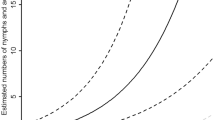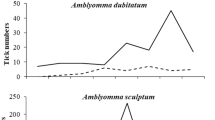Abstract
The ixodid ticks Ixodes ricinus (L., 1758) and I. persulcatus Sch., 1930 are the main vectors of tick-borne encephalitis and Lyme disease pathogens in Karelia. Since the outlines of the natural foci of these infections fully coincide with the distributions of the taiga and castor bean ticks, research into the patterns of their spatial distribution is of high relevance. The results of long-term transect surveys, presented herein, demonstrate changes in the distribution and abundance of I. ricinus since the 1950s. The overall geographic distribution of I. ricinus in Karelia is presently characterized by reduction of its range, non-uniform distribution, and low numbers. In general, the optimal conditions for this species are restricted to the southwestern agroclimatic zone (mostly the territory of Lakhdenpokhskii District), where it also occurred in the past. Changes in the occurrence of I. ricinus can be observed both in its non-shared habitats and in the areas which the species inhabits sympatrically with the taiga tick I. persulcatus. The areas occupied by I. ricinus alone in the western part of the southern agroclimatic zone and also the sympatric areas in the central part of this zone have shrunk, while the sympatric areas in the southwestern zone (Pitkyarantskii and Sortavalskii districts) have grown.

Similar content being viewed by others
REFERENCES
Alfredsson, M., Olafsson, E., Eydal, M., Unnsteinsdottir, E.R., Hansford, K., Wint, W., Alexander, N., and Medlock, J.M., Surveillance of Ixodes ricinus ticks (Acari: Ixodidae) in Iceland, Parasites Vectors, 2017, vol. 10, p. 466. https://doi.org/10.1186/s13071-017-2375-2
Bespyatova, L.A. and Bugmyrin, S.V., Distribution and abundance of Ixodes persulcatus and I. ricinus (Acari: Ixodidae) in Karelia, in Materialy mezhdunarodnoi konf. “Fundamental’nye i prikladnye aspekty izucheniya paraziticheskikh chlenistonogikh v XXI veke” pamyati chlena-korrespondenta RAN Yu.S. Balashova (Fundamental and Applied Aspects of Studying Parasitic Arthropods in the XXI Century: Proc. of Int. Conf. Dedicated to the Memory of Yu.S. Balashov), St. Petersburg, 2013, p. 34.
Bespyatova, L.A. and Bugmyrin, S.V., Species composition and distribution of the main vectors and epidemiological situation with tick-borne encephalitis in the Republic of Karelia, Aktual. Vopr. Vet. Biol., 2017, no. 1, p. 13.
Bobrovskikh, T.K., Iksodovye kleshchi (podsemeistvo Ixodinae) Karelii (Ixodid Ticks (Subfamily Ixodinae) of Karelia), Petrozavodsk, 1989.
Bugmyrin, S.V., Bespyatova, L.A., Korotkov, Y.S., Burenkova, L.A., Belova, O.A., Romanova, L.Iu., Kozlovskaya, L.I., Karganova, G.G., and Ieshko, E.P., Distribution of Ixodes ricinus and I. persulcatus ticks in southern Karelia (Russia), Ticks Tick-Borne Dis., 2013, vol. 4, no. 1, p. 57. https://doi.org/10.1016/j.ttbdis.2012.07.004
Bugmyrin, S.V., Bespyatova, L.A., and Martyanov, R.S., Distribution and abundance of ixodid ticks (Acari: Ixodidae) on the islands of the Kizhi Archipelago, Tr. Karel. Nauchn. Tsentra Ross. Akad. Nauk, 2014, no. 2, p. 119.
Bugmyrin, S.V., Bespyatova, L.A., Kotovsky, N.Yu., and Ieshko, E.P., Species composition and abundance of ixodid ticks (Acari: Ixodidae) in Petrozavodsk (Republic of Karelia, Russia), Tr. Karel. Nauchn. Tsentra Ross. Akad. Nauk, 2016, no. 3, p. 67. https://doi.org/10.17076/bg225
Bugmyrin, S., Bespyatova, L., and Kaushinis, T., Ticks (Acari: Ixodidae) in Karelia. Occurrence dataset, Version 1.1. Karelian Research Centre of the Russian Academy of Sciences, 2020 (Accessed 24.02.2020). https://www.gbif.org/dataset/b7ce62f1-8e9d-467b-8889-af1a2158321a
Ciebiera, O., Jerzak, L., Nowak-Chmura, M., and Bocheński, M., Ticks (Acari: Ixodida) on birds (Aves) migrating through the Polish Baltic coast, Exp. Appl. Acarol., 2019, vol. 77, no. 2, p. 241. https://doi.org/10.1007/s10493-019-00341-z
Filippova, N.A., Fauna SSSR. Paukoobraznye (Fauna of the USSR. Arachnida), Vol. 4, Issue 4: Iksodovye kleshchi podsemeistva Ixodinae (Ixodid Ticks of the Subfamily Ixodinae), Leningrad: Nauka, 1977.
Hasle, G., Bjune, G., Edvardsen, E., Jakobsen, C., Linnehol, B., Røer, J.E., Mehl, R., Røed, K.H., Pedersen, J., and Leinaas, H., Transport of ticks by migratory passerine birds to Norway, J. Parasitol., 2009, vol. 95, no. 6, p. 1342. https://doi.org/10.1645/GE-2146.1
Hvidsten, D., Frafjord, K., Gray, J.S., Henningsson, A.J., Jenkins, A., Kristiansen, B.E., Lager, M., Rognerud, B., Slåtsve, A.M., Stordal, F., Stuen, S., and Wilhelmsson, P., The distribution limit of the common tick, Ixodes ricinus, and some associated pathogens in north-western Europe, Ticks Tick-Borne Dis., 2020, vol. 11, no. 4: 101388. https://doi.org/10.1016/j.ttbdis.2020.101388
Jaenson, T.G., Jaenson, D.G., Eisen, L., Petersson, E., and Lindgren, E., Changes in the geographical distribution and abundance of the tick Ixodes ricinus during the past 30 years in Sweden, Parasites Vectors, 2012, vol. 5, art. 8. https://doi.org/10.1186/1756-3305-5-8
Kheisin, E.M., On the northern distribution boundary of Ixodes ricinus and I. persulcatus in the Karelo-Finnish SSR, Zool. Zh., 1950, vol. 29, no. 6, p. 572.
Korenberg, E.I., Biokhorologicheskaya struktura vida (na primere taezhnogo kleshcha) (The Biochorological Structure of a Species: A Case Study of the Taiga Tick), Moscow: Nauka, 1979.
Korenberg, E.I., Boundaries and types of ranges, in Taezhnyi kleshch Ixodes persulcatus Schulze (Acarina, Ixodidae) (The taiga tick Ixodes persulcatus Schulze (Acarina, Ixodidae)), Filippova, N.A., Ed., Leningrad: Nauka, 1985, p. 188.
Korenberg, E.I., Pomelova, V.G., and Osin, N.S., Prirodnoochagovye infektsii, peredayushchiesya iksodovymi kleshchami (Natural Focal Infections Transmitted by Ixodid Ticks), Moscow, 2013.
Laaksonen, M., Sajanti, E., Sormunen, J.J., Penttinen, R., Hänninen, J., Ruohomäki, K., Sääksjärvi, I., Vesterinen, E.J., Vuorinen, I., Hytönen, J., and Klemola, T., Crowdsourcingbased nationwide tick collection reveals the distribution of Ixodes ricinus and I. persulcatus and associated pathogens in Finland, Emerging Microbes Infect., 2017, vol. 6, art. e31. https://doi.org/10.1038/emi.2017.17
Lindgren, E., Tälleklint, L., and Polfeldt, T., Impact of climatic change on the northern latitude limit and population density of the disease-transmitting European tick Ixodes ricinus, Environ. Health Perspect., 2000, vol. 108, no. 2, p. 119. https://doi.org/10.1289/ehp.00108119
Lutta, A.S., 25 years of arachnoentomological research in Karelia, in Parazitologicheskie issledovaniya v Karel’skoi ASSR i Murmanskoi oblasti (Parasitological Studies in the Karelian ASSR and Murmansk Province), Petrozavodsk, 1976, p. 4.
Lutta, A.S., Kheisin, E.M., and Shulman, R.E., On distribution and ecology of ixodid ticks in the Karelo-Finnish SSR, Uch. Zap. Karelo-Fin. Univ., 1954, vol. 5, no. 3, p. 57.
Lutta, A.S., Kheisin, E.M., and Shulman, R.E., On the distribution of ixodid ticks in Karelia, in Voprosy parazitologii Karelii. Trudy Karel’skogo Filiala Akademii Nauk SSSR (Problems of Parasitology in Karelia: Proceedings of the Karelian Branch of the Academy of Sciences of the USSR), Issue 14, 1959a, p. 72.
Lutta, A.S., Kheisin, E.M., and Shulman, R.E., Iksodovye kleshchi KASSR i mery bor’by s nimi (Ixodid Ticks of the Karelian ASSR and Measures of Their Control), Petrozavodsk, 1959b.
Movila, A., Alekseev, A.N., Dubinina, H.V., and Toderas, I., Detection of tick-borne pathogens in ticks from migratory birds in the Baltic region of Russia, Med. Vet. Entomol., 2013, vol. 27, no. 1, p. 113. https://doi.org/10.1111/j.1365-2915.2012.01037.x
Olenev, N.O., On the northern distribution boundaries of Ixodoidea on different continents, Izv. Akad. Nauk SSSR, 1934, no. 2, p. 367.
Olenev, N.O., On the study of Ixodes ticks in the Northwest of the USSR, Med. Parazitol. Parazitar. Bolezni, 1939, vol. 8, no. 3, p. 321.
Pomerantsev, B.I., Geographic distribution of Ixodoidea ticks and composition of their faunas in the Palaearctic, Tr. Zool. Inst. Akad. Nauk SSSR, 1948, vol. 7, p. 132.
Romanov, A.A., O klimate Karelii (On the Climate of Karelia), Petrozavodsk, 1961.
Shorthouse, D.P., SimpleMappr, an Online Tool to Produce Publication-Quality Point Maps, 2010 (Accessed 15.05.2020). https://www.simplemappr.net
ACKNOWLEDGMENTS
We are sincerely grateful to our colleagues G.G. Karganova, O.A. Belova, I.S. Kholodilov, L.V. Gmyl (Chumakov Federal Scientific Center for Research and Development of Immune-and-Biological Products of the Russian Academy of Sciences, Moscow) and A.V. Korosov (Petrozavodsk State University) for long-term participation in our field research. Special thanks are due to E.I. Korenberg (Gamaleya National Research Center for Epidemiology and Microbiology, Moscow) for valuable advice and comments on the manuscript.
Funding
This study was supported by State Research Assignment 0218-2019-0075 at the Karelian Research Center of the Russian Academy of Sciences.
Author information
Authors and Affiliations
Corresponding author
Ethics declarations
The authors declare that they have no conflict of interest. All the applicable international, national, and/or institutional guidelines for the care and use of animals were followed. All the procedures performed in studies involving animals were in accordance with the ethical standards of the institution or practice at which the studies were conducted.
Additional information
Translated from Zoologicheskii Zhurnal, 2021, Vol. 100, No. 7, pp. 745–755 https://doi.org/10.31857/S0044513421070035.
Rights and permissions
About this article
Cite this article
Bespyatova, L.A., Bugmyrin, S.V. On the Distribution of the Castor Bean Tick Ixodes ricinus (Acarina, Ixodidae) in the Republic of Karelia, Russia. Entmol. Rev. 101, 581–591 (2021). https://doi.org/10.1134/S0013873821040084
Received:
Revised:
Accepted:
Published:
Issue Date:
DOI: https://doi.org/10.1134/S0013873821040084




